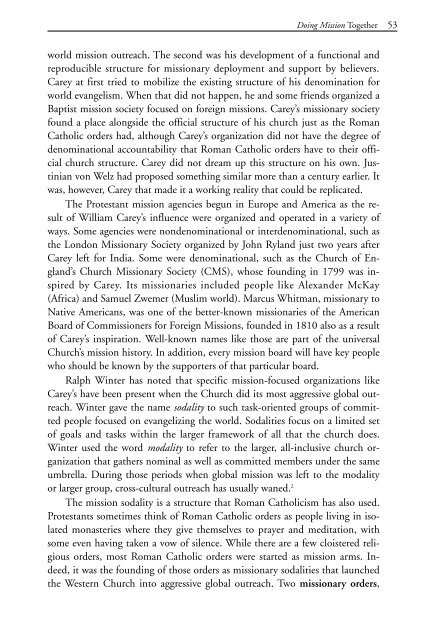discovering missions - Southern Nazarene University
discovering missions - Southern Nazarene University
discovering missions - Southern Nazarene University
Create successful ePaper yourself
Turn your PDF publications into a flip-book with our unique Google optimized e-Paper software.
245187 Disc Missions ins 9/6/07 1:04 PM Page 53<br />
Doing Mission Together 53<br />
world mission outreach. The second was his development of a functional and<br />
reproducible structure for missionary deployment and support by believers.<br />
Carey at first tried to mobilize the existing structure of his denomination for<br />
world evangelism. When that did not happen, he and some friends organized a<br />
Baptist mission society focused on foreign <strong>missions</strong>. Carey’s missionary society<br />
found a place alongside the official structure of his church just as the Roman<br />
Catholic orders had, although Carey’s organization did not have the degree of<br />
denominational accountability that Roman Catholic orders have to their official<br />
church structure. Carey did not dream up this structure on his own. Justinian<br />
von Welz had proposed something similar more than a century earlier. It<br />
was, however, Carey that made it a working reality that could be replicated.<br />
The Protestant mission agencies begun in Europe and America as the result<br />
of William Carey’s influence were organized and operated in a variety of<br />
ways. Some agencies were nondenominational or interdenominational, such as<br />
the London Missionary Society organized by John Ryland just two years after<br />
Carey left for India. Some were denominational, such as the Church of England’s<br />
Church Missionary Society (CMS), whose founding in 1799 was inspired<br />
by Carey. Its missionaries included people like Alexander McKay<br />
(Africa) and Samuel Zwemer (Muslim world). Marcus Whitman, missionary to<br />
Native Americans, was one of the better-known missionaries of the American<br />
Board of Commissioners for Foreign Missions, founded in 1810 also as a result<br />
of Carey’s inspiration. Well-known names like those are part of the universal<br />
Church’s mission history. In addition, every mission board will have key people<br />
who should be known by the supporters of that particular board.<br />
Ralph Winter has noted that specific mission-focused organizations like<br />
Carey’s have been present when the Church did its most aggressive global outreach.<br />
Winter gave the name sodality to such task-oriented groups of committed<br />
people focused on evangelizing the world. Sodalities focus on a limited set<br />
of goals and tasks within the larger framework of all that the church does.<br />
Winter used the word modality to refer to the larger, all-inclusive church organization<br />
that gathers nominal as well as committed members under the same<br />
umbrella. During those periods when global mission was left to the modality<br />
or larger group, cross-cultural outreach has usually waned. 2<br />
The mission sodality is a structure that Roman Catholicism has also used.<br />
Protestants sometimes think of Roman Catholic orders as people living in isolated<br />
monasteries where they give themselves to prayer and meditation, with<br />
some even having taken a vow of silence. While there are a few cloistered religious<br />
orders, most Roman Catholic orders were started as mission arms. Indeed,<br />
it was the founding of those orders as missionary sodalities that launched<br />
the Western Church into aggressive global outreach. Two missionary orders,

















